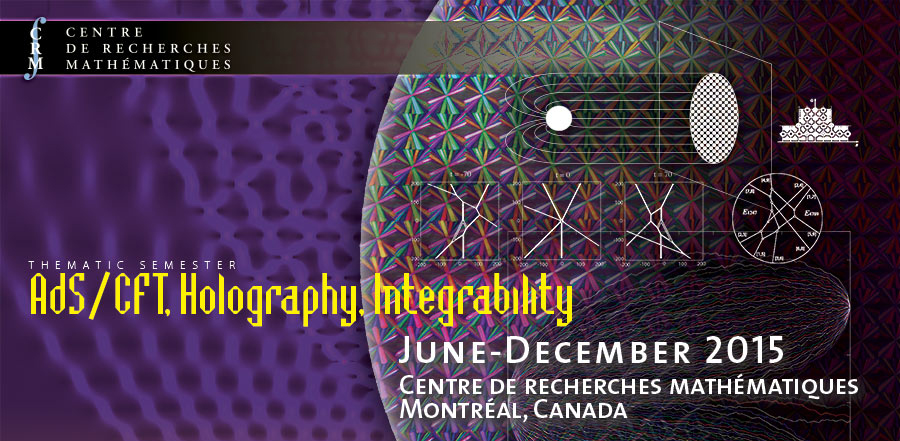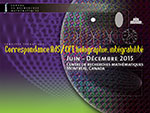Full Description
From the present standpoint, the collection of ideas relating theories of quantum gravity on negatively curved space-times to conformal quantum field theories on their boundaries is a coherent and firmly established theoretical framework for fundamental physics. The AdS/CFT conjecture postulates an exact equivalence between, specifically, type IIB string theory on ${\it AdS}_5\times {S}^5$ and maximally supersymmetric Yang-Mills theory on the boundary, and gives a concrete realization of the holographic principle. It is supported by a large number of explicit calculation of spectra and other physical observables, and has led to a number of new insights into both quantum gravity and field theory. At the same time, there are also so many open questions (apart from the mathematical proof of the conjecture itself, which likely would also lead to profound new mathematical insights) that physicists and mathematicians will be occupied for a long time to come. Integrability has emerged in the last decade as a most powerful tool for making progress into the genuinely strongly coupled regime of the duality. This has not always been so.
The idea that the mathematical problems of Quantum Gravity might ultimately be intertwined with the difficulties of Quantum Field Theory hatched about forty years ago when the early dual resonance models for strong interactions developed into string theory as a candidate for a theory of all of fundamental physics. An early hint that the experimentally successful theory of the strong force, QCD, remained related to strings was the observation of 't Hooft that perturbative Feynman diagrams re-organize into a planar diagram expansion in the large-$N$ limit.
Concurrently, what might now be interpreted as the first hints that quantum gravity should be holographic began to slowly emerge in the 1970's, starting with the discovery of the area law for the entropy of black holes by Bekenstein and Hawking, and developing in work of Polyakov, 't Hooft, Susskind and others. For a long time, general acceptance was hampered by the lack of an explicitly computable model in which the reduction of the number of degrees of freedom could be checked quantitatively. This situation changed in a dramatic way with Maldacena's epoch making work \cite{malda}. Inspired in part by the discovery of D-branes and by the microscopic explanation of black hole entropy in string theory, Maldacena proposed an {\it exact quantum equivalence} between type IIB string theory in anti-de Sitter space and maximally supersymmetric Yang-Mills theory on its boundary. This duality has passed a large number of quantitative tests (including spectra of chiral and non-BPS operators, correlation functions, expectation values of Wilson loops, thermodynamic properties, and many more).
The discovery that integrable structures are present in certain physical systems that occur in nature has led, since the late 1960's, to a tremendous amount of theoretical activity on these types of systems that are both exactly solvable and display a remarkable stability, yet are genuinely non-linear interacting systems often with an infinite number of degrees of freedom. The main technique applicable to classical systems is the inverse scattering-Riemann-Hilbert method, while quantum mechanical systems are typically solved by factorization techniques (Bethe ansatz, etc.). Both of those groups of techniques have entered in an important way in recent developments in AdS/CFT.
In fact, infinite symmetry algebras have always played an important role in string theory, and have shaped important parallel developments in field theory along the way. For example, the study of the Virasoro and super-Virasoro algebra as the gauge algebra of perturbative string theory led to the development of vertex operator algebras, and 2-dimensional rational conformal field theories remain classic examples of exactly solvable models in quantum field theory. In a different way, integrable systems started playing a fundamental role in topological field and string theory after Witten and Kontsevich's work on intersection theory on the moduli space of algebraic curves. The appearance of integrable systems on the two sides of the AdS/CFT correspondence, as well as the remarkable relation between four-dimensional supersymmetric and two-dimensional integrable quantum field theories initiated by Alday-Gaiotto-Tachikawa and Nekrasov-Shatashvili are but the most recent in a long chain of connections.
For a comprehensive review of integrable structures in AdS/CFT, see \cite{beisertetal}. In field theory, the calculation of the spectrum of anomalous dimensions in the planar limit of ${\mathcal N}=4$ super-Yang-Mills is identical to the determination of the spectrum of the Hamiltonian of an integrable spin chain, generalizing the Heisenberg spin chain (Minahan-Zarembo, Beisert-Staudacher). On the gravity side, the string worldsheet theory inherits infinite-dimensional symmetry algebras from the highly symmetric target space of the sigma-model (Metsaev-Tseytlin, Bena-Polchinski-Roiban). Exploitation of integrability allows testing the correspondence in regimes of parameter space that extend beyond standard approximation schemes of either theory.
Later advances in this field have led to the formulation of exact equations for the full spectrum of anomalous dimensions of ${\mathcal N}=4$ SYM and ABJM models (AdS/CFT Y-system, thermodynamic Bethe Ansatz, and computation of the spectral curve) as well as to considerable advances in the computation of various physical quantities: correlation functions, Wilson loops, and scattering amplitudes. For the first time, we are close to a rather complete solution of a gauge theory in a physical dimension.
Integrable structures have also surfaced during the calculation of scattering amplitudes in maximally supersymmetric Yang-Mills theory, following Witten's reformulation of perturbative Yang-Mills theory as a string theory in twistor space. They are also instrumental in the exact calculation of expectation values of Wilson loops and the corresponding dual minimal world-sheets.
Work on AdS/CFT is motivated by some of the most fundamental questions in contemporary theoretical physics: the solution of the conundrums associated with black holes and early universe cosmology on the quantum gravity side, and the elevation of quantum Yang-Mills theory to a mathematically rigorous framework on the field theory side. The importance of these problems can be succinctly summarized in the attention they have caught as targets of some prestigious modern Science Prizes: ``Yang-Mills existence and mass gap'' is one of the 6 unsolved Clay Millenium Prize problems, and the list of Laureates of the new ``Fundamental Physics Prize'' includes many of the pioneers and original contributors in the field of quantum gravity, AdS/CFT, black holes, and quantum cosmology. Since the initial proposal by Maldacena, AdS/CFT has had a number of stunning partial successes in addressing these problems (apart from the development and the tests of the conjecture itself), and has fundamentally changed the way in which they are approached. Among other things, AdS/CFT has \\ $\bullet$ shown new ways to calculate microscopically the entropy of black holes \\ $\bullet$ provided a new perspective on confinement and chiral symmetry breaking \\ $\bullet$ opened calculational windows into properties of strongly coupled gauge theory plasmas \\ $\bullet$ given a non-perturbative definition of string theory on Anti-de-Sitter space \\ $\bullet$ essentially settled the debate about unitarity of black hole evaporation \\ $\bullet$ indicated new ``holographic'' approaches to early universe cosmology \\ $\bullet$ sharpened definitions of the notion of the ``wave function of the universe'' \\ $\bullet$ triggered new ideas for beyond the standard model particle physics (extra dimensions, etc.)
Physicists' interest in AdS/CFT has also triggered a number of exciting developments in pure mathematics, for instance in conformal geometry and the spectral geometry of certain Einstein manifolds, in both Minkowski and Euclidean signature. Moreover, thanks to the familiar fact that supersymmetric solutions of supergravity can be characterized algebraically (Calabi-Yau manifolds as cones over Sasaki-Einstein manifolds being the prototypical example), the subject has also connected up with a number of developments in algebraic geometry, the representation theory of certain quiver algebras, and many more. Finally, versions of the correspondence that operate purely within the realm of topological quantum theory have been put forward, such as the relation between topological strings and Chern-Simons gauge theory or matrix models. These correspondences in fact connect up with the circle of ideas relating moduli problems, intersection theory on moduli spaces, (less than maximal) supersymmetric gauge theory with algebraic integrable systems, classical and quantum.
Perhaps the only object that is commensurate to this impressive amount of progress is the list of open problems that one hopes to address using AdS/CFT correspondence. While in principle providing answers to such fundamental questions as the resolution the singularities of classical General Relativity, unitarity of black hole formation and evaporation, the detailed mechanisms behind remain poorly understood. One of the central questions is the emergence of bulk locality from the perspective of the boundary theory, as underlined very recently by the headline generating so-called ``firewall paradox''. A related major challenge is to extend the correspondence such that it applies not only to (asymptotically) AdS backgrounds, which are not realistic from the point of view of cosmological observations. Conversely, while AdS/CFT and its extensions provide holographic duals for several phenomena characteristic of the gauge theories describing our real world (the QCD and electroweak theory), there is no exact dual capturing all their features in a calculable fashion. The hope in applying methods of integrable systems to the maximally supersymmetric situation (and its variants, most notably the correspondence relating type IIA string theory on ${\it AdS}_4\times {{\mathbb C}{\mathbb P}}^3$ to Chern-Simons-Matter theories (ABJM) in 3 dimensions) is to eventually obtain an exact solution of the simplest non-trivial case as a starting point for further approximations.

